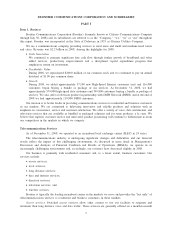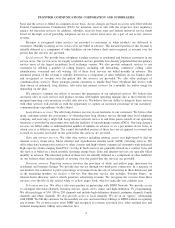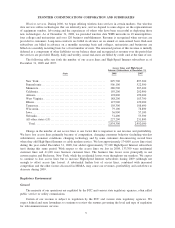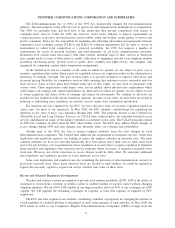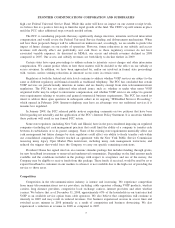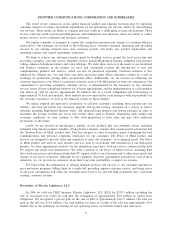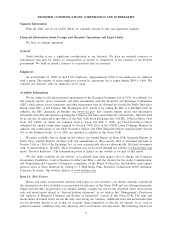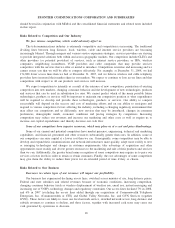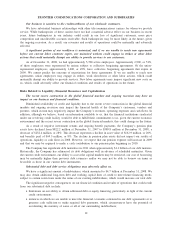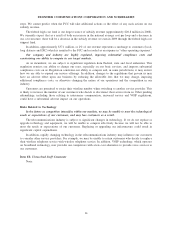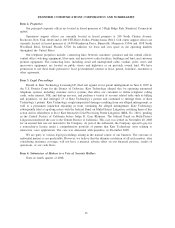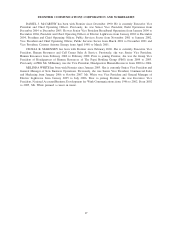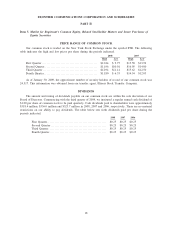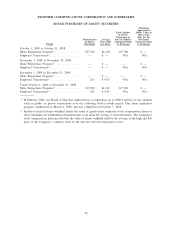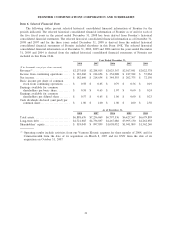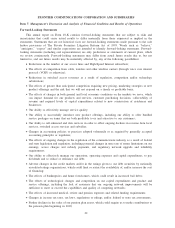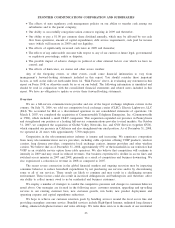Frontier Communications 2008 Annual Report Download - page 14
Download and view the complete annual report
Please find page 14 of the 2008 Frontier Communications annual report below. You can navigate through the pages in the report by either clicking on the pages listed below, or by using the keyword search tool below to find specific information within the annual report.•the allocation of a substantial portion of our cash flow from operations to service our debt, thus reducing
the amount of our cash flow available for other purposes, including operating costs, capital expenditures
and dividends that could improve our competitive position, results of operations or stock price;
•requiring us to sell debt or equity securities or to sell some of our core assets, possibly on unfavorable
terms, to meet payment obligations;
•compromising our flexibility to plan for, or react to, competitive challenges in our business and the
communications industry; and
•the possibility of our being put at a competitive disadvantage with competitors who do not have as much
debt as us, and competitors who may be in a more favorable position to access additional capital
resources.
We will require substantial capital to upgrade and enhance our operations.
Replacing or upgrading our infrastructure will result in significant capital expenditures. If this capital is
not available when needed, our business will be adversely affected. Increasing competition, offering new
services, improving the capabilities or reducing the maintenance costs of our plant may cause our capital
expenditures to increase in the future. In addition, our ongoing annual dividend of $1.00 per share under our
current policy utilizes a significant portion of our cash generated by operations and therefore limits our
operating and financial flexibility and our ability to significantly increase capital expenditures. While we
believe that the amount of our dividend will allow for adequate amounts of cash flow for capital spending and
other purposes, any material reduction in cash generated by operations and any increases in capital
expenditures, interest expense or cash taxes would reduce the amount of cash generated by operations and
available for payment of dividends. Losses of access lines, the effects of increased competition, lower subsidy
and access revenues and the other factors described above may reduce our cash generated by operations and
may require us to increase capital expenditures. In addition, we expect our cash paid for taxes, which increased
significantly in 2008, will continue to increase in 2009.
Risks Related to Regulation
The access charge revenues we receive may be reduced at any time.
A significant portion of our revenues ($285.0 million, or 13% in 2008) is derived from access charges paid
by IXCs for services we provide in originating and terminating intrastate and interstate traffic. The amount of
access charge revenues we receive for these services is regulated by the FCC and state regulatory agencies.
The FCC is considering proposals that may significantly change interstate, intrastate and local intercarrier
compensation. When and how these proposed changes will be addressed are unknown and, accordingly, we are
unable to predict the impact of future changes on our results of operations. However, future reductions in our
access revenues will directly affect our profitability and cash flows as those regulatory revenues do not have
associated variable expenses.
Certain states have open proceedings to address reform to access charges and other intercarrier
compensation. We cannot predict when or how these matters will be decided or the effect on our subsidy or
access revenues. In addition, we have been approached by, and/or are involved in formal state proceedings
with, various carriers seeking reductions in intrastate access rates in certain states. Certain of those claims have
led to formal complaints to the state PUCs. A material reduction in the access revenues we receive would
adversely affect our financial results.
We are reliant on support funds provided under federal and state laws.
We receive a portion of our revenue ($119.8 million, or 5%, in 2008 and $130.0 million, or 6%, in 2007)
from federal and state subsidies, including the federal high cost fund, federal local switching support fund,
federal universal service fund surcharge and various state funds. The FCC and state regulators are currently
considering a number of proposals for changing the manner in which eligibility for federal and state subsidies is
determined as well as the amounts of such subsidies. Although the FCC issued an order on May 1, 2008 to cap
CETC receipts from the high cost Federal Universal Service Fund, which we believe is a positive first step to
limit the rapid growth of the fund, the CETC Cap will only remain in place until the FCC takes additional
13
FRONTIER COMMUNICATIONS CORPORATION AND SUBSIDIARIES


